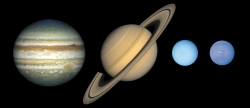You have met your rocky next door space neighbors. Those are the kinds of planets you can stand on without worrying about falling through to the middle (because they're made of rock). The planets a little further out are a lot different. We call them gas giants because, well, they're mostly made up of gases. We will not be landing on these planets, or else we will fall right through. Instead, we will just float around them. It's time to get to know your gassy space neighbors! That's . . . not what it sounds like.

Just in case you were interested in how these planets compare in size.
Our first stop is the most impressive. In fact, we do not have much choice but to stop here. This planet is so big that we are drawn right in by its gravity.
Jupiter is the fifth planet away from the sun and is the biggest in our space neighborhood. Its mass is more than three hundred times the size of Earth! It's far enough away from the sun that it takes almost twelve Earth years for it to move around the sun. Its years may be long, but its days are short, lasting just under ten hours. It spins so fast that large storms form on it. One looks like a giant red eye that's big enough to fit the Earth inside. It feels like that eye is watching us . . . let's keep moving, shall we?

Jupiter is the stormy planet.
The next neighbor is easy to pick out because of the rings moving around it like a buzz saw.
Saturn is the sixth planet from the sun and is known for its many rings of ice and small moons that float around it. Even though it's very far from Earth, Saturn is the second largest planet in our space neighborhood, so we can still see it glowing in the sky with just our eyes. It takes 29.5 years for Saturn to move around the sun, and each day takes about ten days on Earth. I wonder if aliens would ever get annoyed by that big ring blocking out the sun's light. I'm sure it's a lot colder than Earth's sunny middle.

Saturn is easy to remember because it has the rings around it.
We are getting really far out into our space neighborhood now. This next neighbor cannot be seen without a telescope.
Uranus is the seventh planet from the sun and is blue green. It's made up of frozen gases. It's the smallest gas giant, but it's still a great deal larger than Earth. It has an 18-hour day and takes 84 years to move around the sun, but since it's turned on its side, one of its poles stays in the dark for a fourth of its year. Brr. Now you know which part not to live on.

Uranus will not win the planetary beauty contest.
NASA, Public domain, via Wikimedia Commons
Even deeper into space we go. The next neighbor cannot be seen from Earth without a very large telescope.
Neptune is the eighth planet away from the sun and the last planet in our space neighborhood. It's the third largest and moves around the sun once every 165 Earth years and has a 19 hour day. Not much is happening in this very blue place because this far in space everything is just cold . . . and more cold.

Neptune may be blue but you won't find any water on it.
NASA, Public domain, via Wikimedia Commons
Our big gas space neighbors are very big and do not have much going on besides being very cold and very stormy. Jupiter is the biggest and has an angry red eye storm. Saturn is the second biggest and has beautiful rings made of rock and ice. Uranus is a pretty blue green and Neptune, the last neighbor in our space neighborhood is a chilling blue. It all really makes you miss the warm air of Earth . . . Let's head home, shall we?
References:Planets for Kids. "Jupiter" Planets for Kids, 2010. <
http://www.planetsforkids.org/planet-jupiter.html>
Planets for Kids. "Saturn" Planets for Kids, 2010. <
http://www.planetsforkids.org/planet-saturn.html>
Planets for Kids. "Uranus" Planets for Kids, 2010. <
http://www.planetsforkids.org/planet-uranus.html>
Planets for Kids. "Neptune" Planets for Kids, 2010. <
http://www.planetsforkids.org/planet-neptune.html>